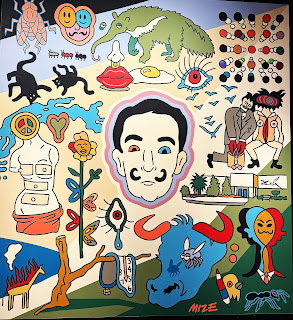 |
| Helen Zughaib's Prayers for Peace |
This multi-media exhibit has three components that flow seamlessly from one another: war and peace, race and gender and religion and conflict. The first work was a large quilt created by Linda Freeman entitled The World Was (9/11). Freeman is a quiltmaker, filmmaker, painter and poet, and she used all of her skills (other than film making) in her works that were included in this exhibit. The 9/11 Quilt was a rain of flowers overlaid on a poem that started "The World Was Numb from 8:45 on Tuesday..." The contrast between the beauty of the quilt and the horrific events that inspired its creation was striking.
 |
| Aminah Robinson's Bedouin Woman |
Flo Oy Wong is an artist who calls herself a visual storyteller. On display were two of her works from the series 1942: Luggage from Home to Camp, which tells the story of Japanese Americans who were sent to interment camps during WWII. People who were sent to internment camps were only permitted to bring two suitcases each, and Wong developed this series after thinking about "the emotional and psychological cramming of their lives" into these suitcases. Each suitcase (which was actually used for the internment) had a wealth of information about its owner and his or her life: pictures of friends and relatives, small items representing their interests and professions and a small mirror to reflect the changes as their lives changed so radically.
 |
| Irene Hardwicke Olivieri's Nature's Clean Up Crew |
Each work in the exhibit was beautiful in its own way. Some works would need to be truly studied in order to understand their full impact. For instance, one piece by Faith Reingold was a map of the United States with acts of violence that occurred in each state set out. One of the events in New York was the Attica prison riot in 1971 in which 1000 inmates took control of the prison, holding 33 staff hostage. Their demands were not for immediate release but for better living conditions. At the end of the four day stand-off, 39 people were dead and 28 of the prisoners' demands were agreed to. (To read more about this event, go to http://en.wikipedia.org/wiki/Attica_Prison_riot .)
In looking at ExhibitUSA's website, it appears that the show is going back home after its stint in Bonita Springs. (Most of the works are on loan from ACA Galleries in New York.) Are no other galleries or visual arts centers in the United States interested enough in this topic to pay the fee to house the show? If so, I wonder if this a result of economic conditions or representative of a more general malaise or a lack of support for the arts. I feel fortunate that the Center for the Arts in Bonita Springs had the vision to bring this exhibit to Southwest Florida and I am glad that I made the time to go see it.
.jpg)


No comments:
Post a Comment